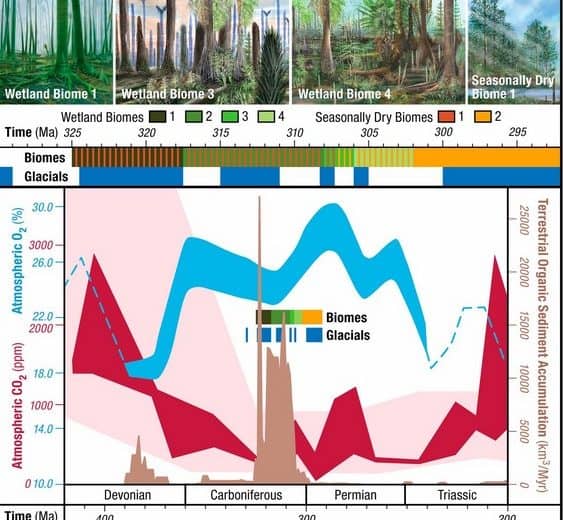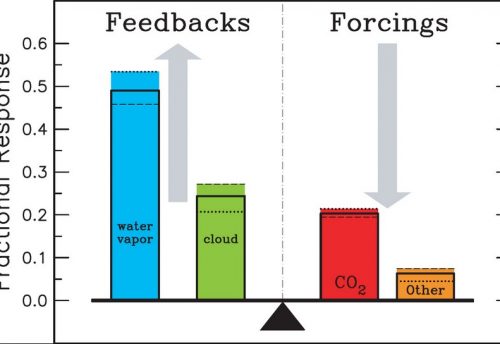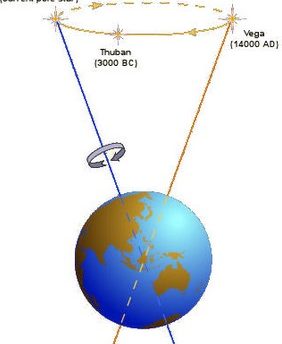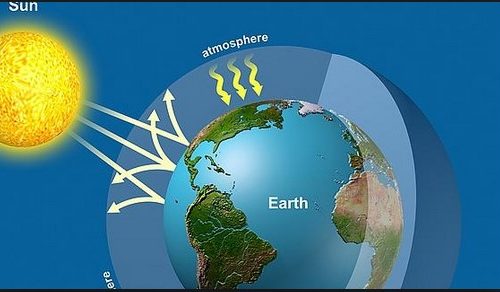
During the early Palaeozoic, about 530Ma, the Northern Hemisphere was entirely oceanic north of about 30N palaeolatitude. Most of today’s Southern Hemisphere continents (India, Antarctica, Australia, Africa, South America) had formed into a super-continent known as Gondwanaland. Sea levels were at or near an all time high, perhaps reflecting increased volcanic activity/oceanic ridge expansion after the break-up of a postulated late Precambrian supercontinent (Bond et al., 1984).
In response to increased tectonic activity, atmospheric carbon dioxide may also have been significantly higher during the early Palaeozoic. Geochemical evidence that links changes in preservation of various species of carbonate minerals with the partial pressure of carbon dioxide in surface waters (and hence the atmosphere) supports this conclusion. Wilkinson & Given (1986) have estimated that the atmospheric concentration of carbon dioxide may have been 10 times higher during the early Palaeozoic than at present. In general, variations in the preservation of marine carbonate species support the sea level/CO2 connection assumed for the Phanerozoic (Sandberg, 1983), and Fischer (1982) has correlated these variations (see Figure 5.2) to conjectured climate (greenhouse-icehouse) supercycles. During low sea stands and lower atmospheric CO2 concentration, high-magnesium carbonate and aragonite shells are preferentially precipitated from ocean water. Conversely, calcite shells are more common during high sea stands and accompanying higher partial pressure of CO2 (pCO2).
shells are preferentially precipitated from ocean water. Conversely, calcite shells are more common during high sea stands and accompanying higher partial pressure of CO2 (pCO2).
With such elevated levels of atmospheric CO2 one would expect a considerable warming associated with greenhouse radiative forcing. Indeed, it seems that the early Palaeozoic was dominated by a maritime climate associated with the expansion of the seaways in the tropics. It is therefore surprising to find evidence (Frakes, 1979) of global ice growth during the Ordovician Period (about 440Ma), at a time when sea levels were at there highest (Figure 5.1), with presumably CO2 concentrations elevated as well. Considerable ice sheet expansion occurred over northern Africa, at that time situated in the vicinity of the South Pole
climate associated with the expansion of the seaways in the tropics. It is therefore surprising to find evidence (Frakes, 1979) of global ice growth during the Ordovician Period (about 440Ma), at a time when sea levels were at there highest (Figure 5.1), with presumably CO2 concentrations elevated as well. Considerable ice sheet expansion occurred over northern Africa, at that time situated in the vicinity of the South Pole .
.
Energy balance models (EBMs) have gone some way to resolve this paradox. Simulations in which the South Pole is located in coastal regions generate low (below freezing) summer temperatures due to the reduced seasonal temperature cycle associated with the coastal environment (Crowley et al., 1987). The influence of enhanced greenhouse forcing due to elevated pCO2 affects only annual temperature, rather than the seasonal cycle. In addition, the continental flooding associated with the early Palaeozoic marine transgression would increase the water surface area, thus reducing further the seasonality, and hence summer temperatures, of the polar region. Geological evidence (Caputo & Crowell, 1985) appears to support the hypothesis of a coastally situated South Pole.
For most of the Silurian and Devonian Periods (410 to 345Ma), there is no evidence for glaciation (Caputo & Crowell, 1985). Although the palaeogeography for the Devonian is uncertain, a South Pole located in central Africa would increase seasonality and summer temperatures, thereby preventing the formation of ice sheets (Crowley et al., 1987). Expansion of land plants also occurred for the first time during the Devonian. Newly vegetated areas would decrease surface albedo (Posey & Clapp, 1964) allowing increased absorption of short-wave radiation. The intensification of the hydrological cycle would also influence climate (Shukla & Mintz, 1982).
A second, and larger ice age began towards the end of the Palaeozoic during the Carboniferous Period (about 305Ma), and continued well into the Permian. Powell & Veevers (1987) have postulated that orogenic uplift in Australia and South America triggered the climatic event. The aerial extent of glaciation covered much of Gondwanaland, and glacial striations (erosional markings due to the movement of glaciers over bedrock) dating from this time have been found in Antarctica, Australia, Africa, India and South America (see Figure 5.3). Again, it appears that the period of major glaciation was associated with a South Pole located at the edge of the Gondwanan supercontinent (Crowley et al., 1987). Such a combination of modelling research and empirical reconstruction appears to favour the hypothesis that climate change was driven by tectonic movements. Additionally, sea levels were at that time falling (Figure 5.1), associated with a slowing down of sea-floor spreading, and presumably a lowering of pCO2 (and greenhouse forcing), as all the continents began to converge.




Leave a Reply